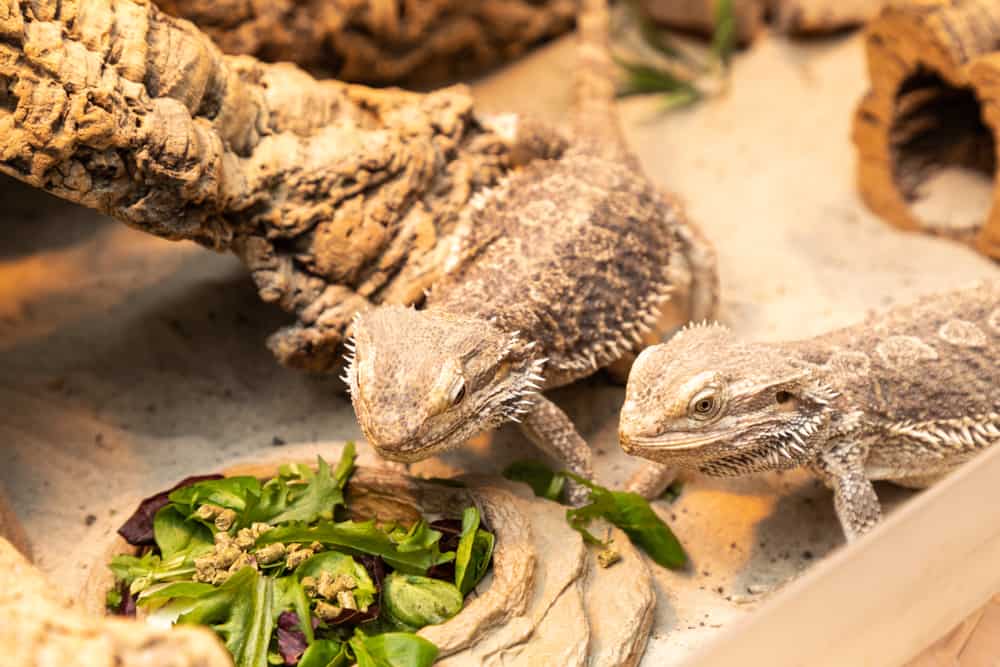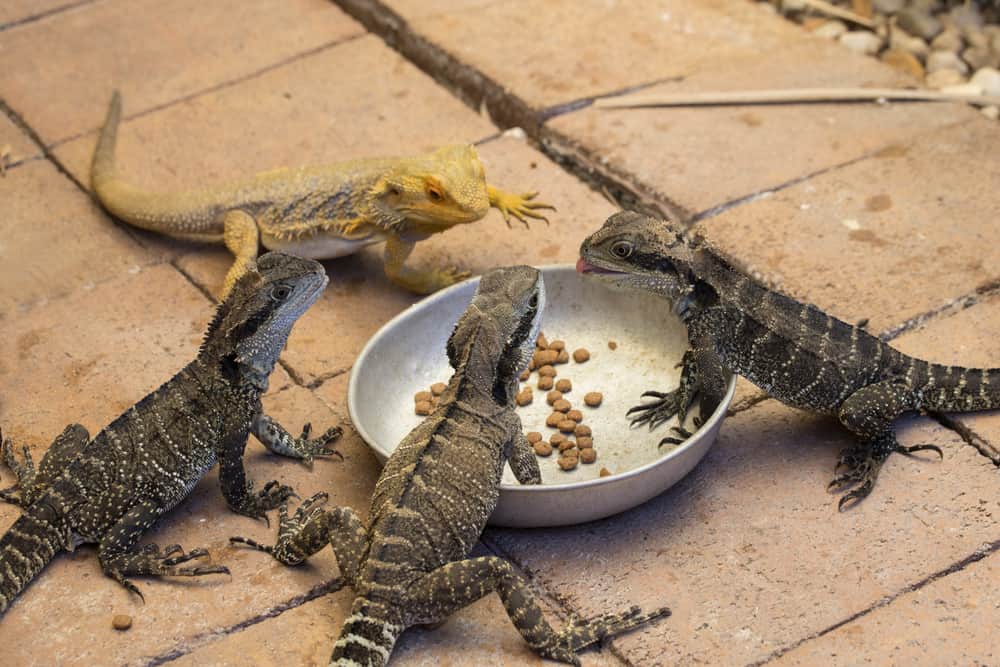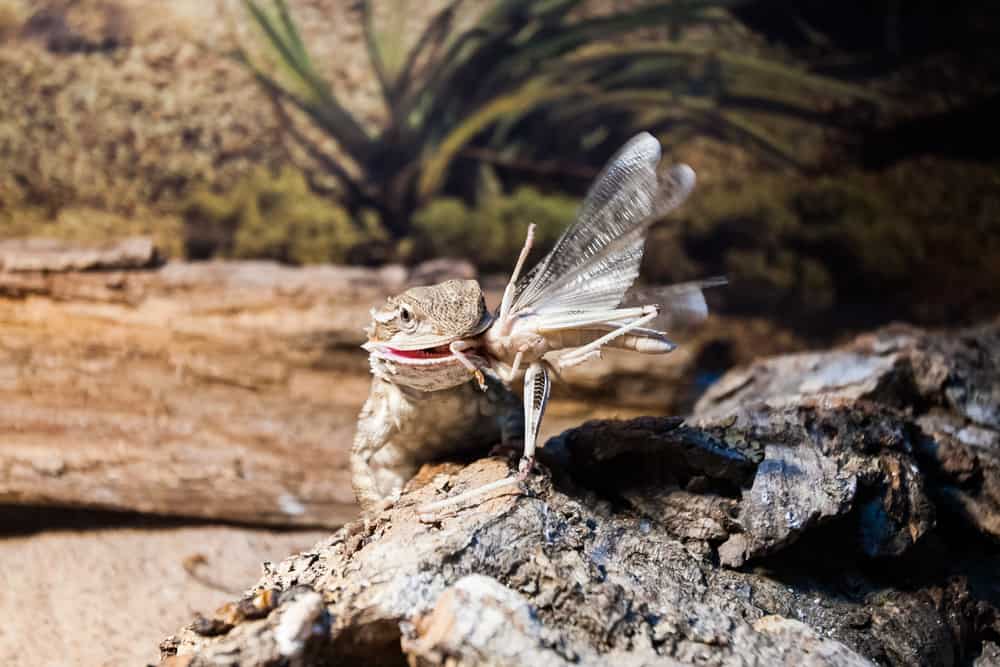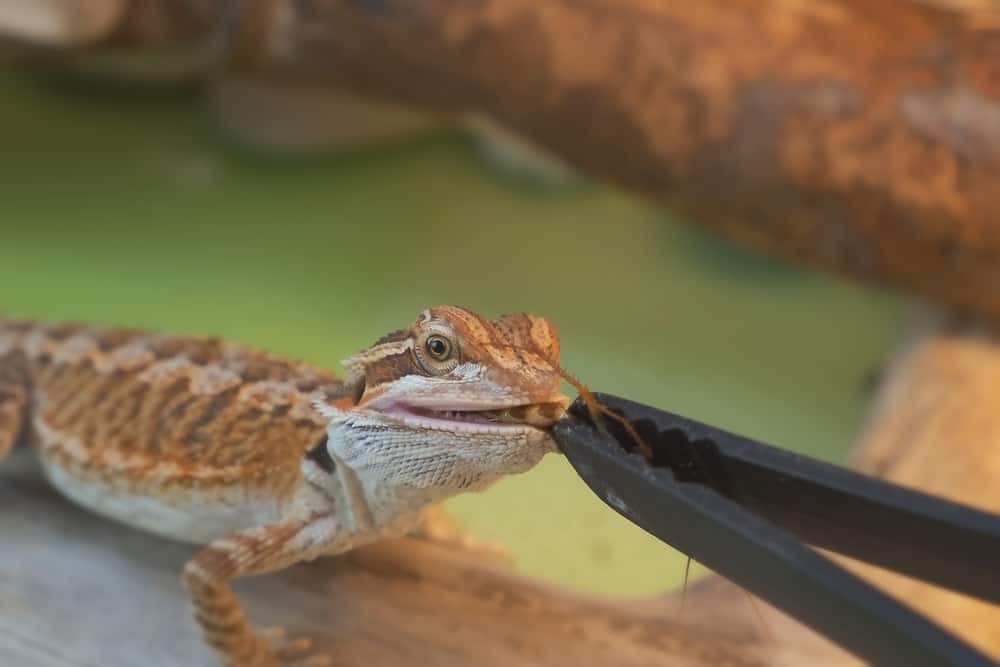A bearded dragon is a common name for a group of lizards living in Australia that is different from every other lizard for its beard below the throat. Puffing out that beard helps this animal show off its mood. The question is what Bearded dragons eat and what are their primary characteristics and habits. Let’s see.
Bearded Dragons Habits and Biology
Bearded dragons are lizards with a low and wide body that helps them grab the surface steadily. They have a high gait while moving at an acceptable speed. The lizard belly is very rubbery, but long thorns on its back make it look unappealing to predators.
You can see these unusual animals in the eastern and central woodlands and deserts of Australia, spending more than 50% of their time in bushes and trees or basking on the rock.
Lizards are usually active during the day, but they often spend nights awake when days are too hot. That is a way to avoid extremely high temperatures and hide in the ground during the hottest part of the day instead.
Interestingly, Bearded dragons’ behavior and gestures are never random, and every movement they make has some meaning. As you have known, they can change body color, and each one has a particular purpose, according to their health and mood changes.
For instance, Bearded dragons change color for temperature regulation. Since black-colored surfaces attract more light and warmth, they will usually turn light yellow while basking outside. During cold weather, their color will turn dark brown.
When you find yourself in front of a bearded dragon, it will surely raise its front foot and wave you. It is the way of saying hi or showing peaceful intentions. Insecure and young bearded dragons perform this particular movement more often than adults.
These lizards became popular on the exotic reptile pets market in the 1990s and got the favorite pet title in the UK back in 2008. Believe it or not, more than 9.5 million bearded dragons were pets in 5 million American homes in 2017.
Do Bearded Dragons Eat Dirt?
Bearded dragons won’t eat dirt on purpose, only in specific cases. Vivarium for bearded dragons should be as similar as possible to their natural habitat. Since they live in eastern and central Australian deserts, sand makes an excellent substrate for it.
These animals are small, and their prey is usually the same size or smaller. As you can guess, they eat food from the ground, so it is possible to swallow some dirt and sand by accident while enjoying their food.
They eat sand on purpose only when they have a low calcium level due to a poor diet. Overeating sand may lead to severe health issues and even death because their digestive system can’t digest such minerals.
What Do Bearded Dragons Like to Eat Most?
Bearded dragons are omnivorous and can eat almost everything, including insects, worms, vegetables, and fruit. Their feeding rhythm depends on their age:
- Up to 6 months old hatchlings eat vegetables primarily but need insects two times a day
- 6 to 12 months old juveniles consume vegetables but enjoy an insect meal once a day
- Adults older than 12 months eat insects 1 to 2 times a week plus vegetables whenever they want
Vegetables
Vegetables and greens are full of vitamins and are crucial for every bearded dragon. Even the youngest animals should eat salads, although they probably won’t eat the whole portion you prepare.
Keep in mind that Bearded dragons can refuse to eat the same vegetable sorts offered, so you need to make various combinations.
Only balanced vegetable meals provide needed nutrition and vitamins for your pet since some greens are good for bones while others are necessary for the immune system. The list includes:
- Arugula, turnip greens, and chicory
- Spring greens, watercress, and escarole
- Kale, swiss chard, cabbage, and a bit of broccoli
- Mustard greens and mustard cress
- Peas, green beans, and pea shoots
- Courgette, butternut squash, yellow squash, and acorn squash
- Sweet potato
- Bell pepper
- Okra and cactus pads
- Kohlrabi, parsnip, and asparagus
Remember that you need to cut offered vegetables into thin pieces that are easy to bite since Bearded dragons grab food with their tongue. Additionally, veggies need to be fresh and yummy. Wet or slimy pieces won’t stick to their tongue, which will make your bearded dragon stressed and nervous.
Fruit
Fruit is crucial food for Bearded dragons as much as vegetables, but it has more water and sugar. Therefore, you need to take care of offered quantities to keep your pet healthy.
For instance, you can offer fruit occasionally to prevent your pet obesity and some diseases connected with high sugar content. The best options for Bearded dragons include:
- Apples and pears
- Mango, papaya, guava, and kiwi
- Figs and dates
- Bananas
- Peaches and apricots
- Plums
- Strawberries and blueberries
- Grapes and raisins
- Watermelon
You should avoid giving your Bearded dragon citrus fruits because they may upset its stomach. Plus, never feed your pet with soft and sugary fruit since they may cause teeth problems.
Meat
Bearded dragons can’t eat meat except for insects and worms. Keep in mind that some insects can be bigger than your pet, so you should pay attention to the species you offer. The rule of thumb is to use space between your Bearded dragon’s eyes to measure the appropriate insect size.
On the other hand, it is not crucial for worms so that you can offer your pet any of them regardless of their size. A list of the insect you can provide is wide and includes:
- Crickets
- Dubia roaches and cockroaches
- Butter worms and earthworms
- Snails
Food Avoid to Feed Your Bearded Dragons
Although Bearded dragons are omnivores, they still don’t eat everything. Be careful since some food can be harmful to their bodies, but they will eat it anyway. Your job is to take care of the meal offered and avoid harmful ingredients, like:
- Citrus fruit, particularly lemon
- Avocado is often full of chemicals that are poisonous or even fatal for Bearded dragons
- Eggplants are way too acidic for your pet
- Iceberg and celery are low in nutritional value and full of water
- Spinach and beet tops packed with chemicals often lead to calcium deficiency and metabolic disease
- Rhubarb contains oxalic acid is deadly poisonous to these animals
- Onions and chives
- Mushrooms
- Seafood
- High phosphorous food like sweet and russet potatoes, corn, and bananas are not recommended in larger quantities
- Dairy products are useless for Bearded dragons since their bodies can’t produce the enzymes needed to digest milk or cheese
- Wild insects you can catch outside often carry parasites that can be harmful to your Bearded dragon
- Boxelder bugs
- Fireflies and any other glowing insects will lead to your pet’s body damage
- Caterpillars and butterflies spend all day eating different plants that can be potentially poisonous to your Bearded dragon
- Venomous insects like scorpions, bees, hornets, wasps, and spiders are not a desired food for Bearded dragons since they are deadly poisonous for these animals
Tips to Feed Bearded Dragons
Feeding a Bearded dragon is not very difficult. The only thing you need to do is to find high-quality food that fits its digestive system. Therefore, you should check a few crucial tips that will help you keep this fantastic animal healthy and prosperous.
Become familiar with food adequate for this species – Keep in mind that Bearded dragons can’t consume some food types, so take care to provide a proper meal for your pet.
Appropriate feeding ratios – Be aware that Bearded dragons eat various things according to their age. While younger animals need more meat-based proteins from insects, adults often prefer vegetables and fruits.
Purchase proper insects – Almost every shop for exotic pets has the necessary equipment for Bearded dragons. They also offer insects for feeding these animals, and your job is to buy those your pet enjoys the most and store them properly.
If you are a novice in this field, it is better to consult with someone experienced about the insect type you need to purchase. Remember that not all of them have the same nutritional value, so you should be careful to make a balanced diet for your pet.
Fresh vegetables – Your Bearded dragon will require a daily dose of vitamins besides proteins. Fresh salad from vegetables and greens provides enough vitamins, but pieces should be bite-sized. Be careful since not all veggies and fruit are suitable for your pet.
Continual feeding – It is necessary to feed your lizard 2 to 3 times a day. Try to establish a daily rhythm and offer it some food at the same time during the day.
Avoid troubles by behaving responsibly – Always take the bowl out of the vivarium while preparing the meal to prevent your pet from escaping. Always put food in the bowl to prevent your Bearded dragon from intaking the substrate while eating. Monitor your pet while eating to be sure that it can digest everything offered.
Summary
Taking care of a Bearded dragon is an easy task while sticking to the rules. Pick out the proper, high-quality food, make sure it is healthy, and avoid ingredients that can be harmful to these animals. That’s all.




Thanks, It’s Help me lots